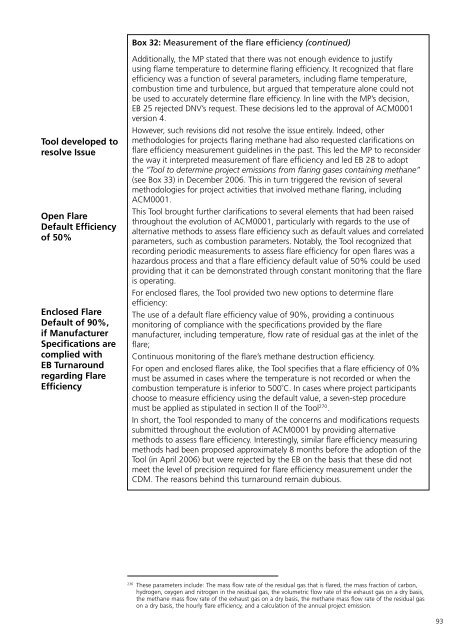Understanding CDM Methodologies - SuSanA
Understanding CDM Methodologies - SuSanA
Understanding CDM Methodologies - SuSanA
Create successful ePaper yourself
Turn your PDF publications into a flip-book with our unique Google optimized e-Paper software.
Box 32: Measurement of the flare efficiency (continued)<br />
Tool developed to<br />
resolve Issue<br />
Open Flare<br />
Default Efficiency<br />
of 50%<br />
Enclosed Flare<br />
Default of 90%,<br />
if Manufacturer<br />
Specifications are<br />
complied with<br />
EB Turnaround<br />
regarding Flare<br />
Efficiency<br />
Additionally, the MP stated that there was not enough evidence to justify<br />
using flame temperature to determine flaring efficiency. It recognized that flare<br />
efficiency was a function of several parameters, including flame temperature,<br />
combustion time and turbulence, but argued that temperature alone could not<br />
be used to accurately determine flare efficiency. In line with the MP’s decision,<br />
EB 25 rejected DNV’s request. These decisions led to the approval of ACM0001<br />
version 4.<br />
However, such revisions did not resolve the issue entirely. Indeed, other<br />
methodologies for projects flaring methane had also requested clarifications on<br />
flare efficiency measurement guidelines in the past. This led the MP to reconsider<br />
the way it interpreted measurement of flare efficiency and led EB 28 to adopt<br />
the “Tool to determine project emissions from flaring gases containing methane”<br />
(see Box 33) in December 2006. This in turn triggered the revision of several<br />
methodologies for project activities that involved methane flaring, including<br />
ACM0001.<br />
This Tool brought further clarifications to several elements that had been raised<br />
throughout the evolution of ACM0001, particularly with regards to the use of<br />
alternative methods to assess flare efficiency such as default values and correlated<br />
parameters, such as combustion parameters. Notably, the Tool recognized that<br />
recording periodic measurements to assess flare efficiency for open flares was a<br />
hazardous process and that a flare efficiency default value of 50% could be used<br />
providing that it can be demonstrated through constant monitoring that the flare<br />
is operating.<br />
For enclosed flares, the Tool provided two new options to determine flare<br />
efficiency:<br />
The use of a default flare efficiency value of 90%, providing a continuous<br />
monitoring of compliance with the specifications provided by the flare<br />
manufacturer, including temperature, flow rate of residual gas at the inlet of the<br />
flare;<br />
Continuous monitoring of the flare’s methane destruction efficiency.<br />
For open and enclosed flares alike, the Tool specifies that a flare efficiency of 0%<br />
must be assumed in cases where the temperature is not recorded or when the<br />
combustion temperature is inferior to 500˚C. In cases where project participants<br />
choose to measure efficiency using the default value, a seven-step procedure<br />
must be applied as stipulated in section II of the Tool 270 .<br />
In short, the Tool responded to many of the concerns and modifications requests<br />
submitted throughout the evolution of ACM0001 by providing alternative<br />
methods to assess flare efficiency. Interestingly, similar flare efficiency measuring<br />
methods had been proposed approximately 8 months before the adoption of the<br />
Tool (in April 2006) but were rejected by the EB on the basis that these did not<br />
meet the level of precision required for flare efficiency measurement under the<br />
<strong>CDM</strong>. The reasons behind this turnaround remain dubious.<br />
236<br />
These parameters include: The mass flow rate of the residual gas that is flared, the mass fraction of carbon,<br />
hydrogen, oxygen and nitrogen in the residual gas, the volumetric flow rate of the exhaust gas on a dry basis,<br />
the methane mass flow rate of the exhaust gas on a dry basis, the methane mass flow rate of the residual gas<br />
on a dry basis, the hourly flare efficiency, and a calculation of the annual project emission.<br />
93

















